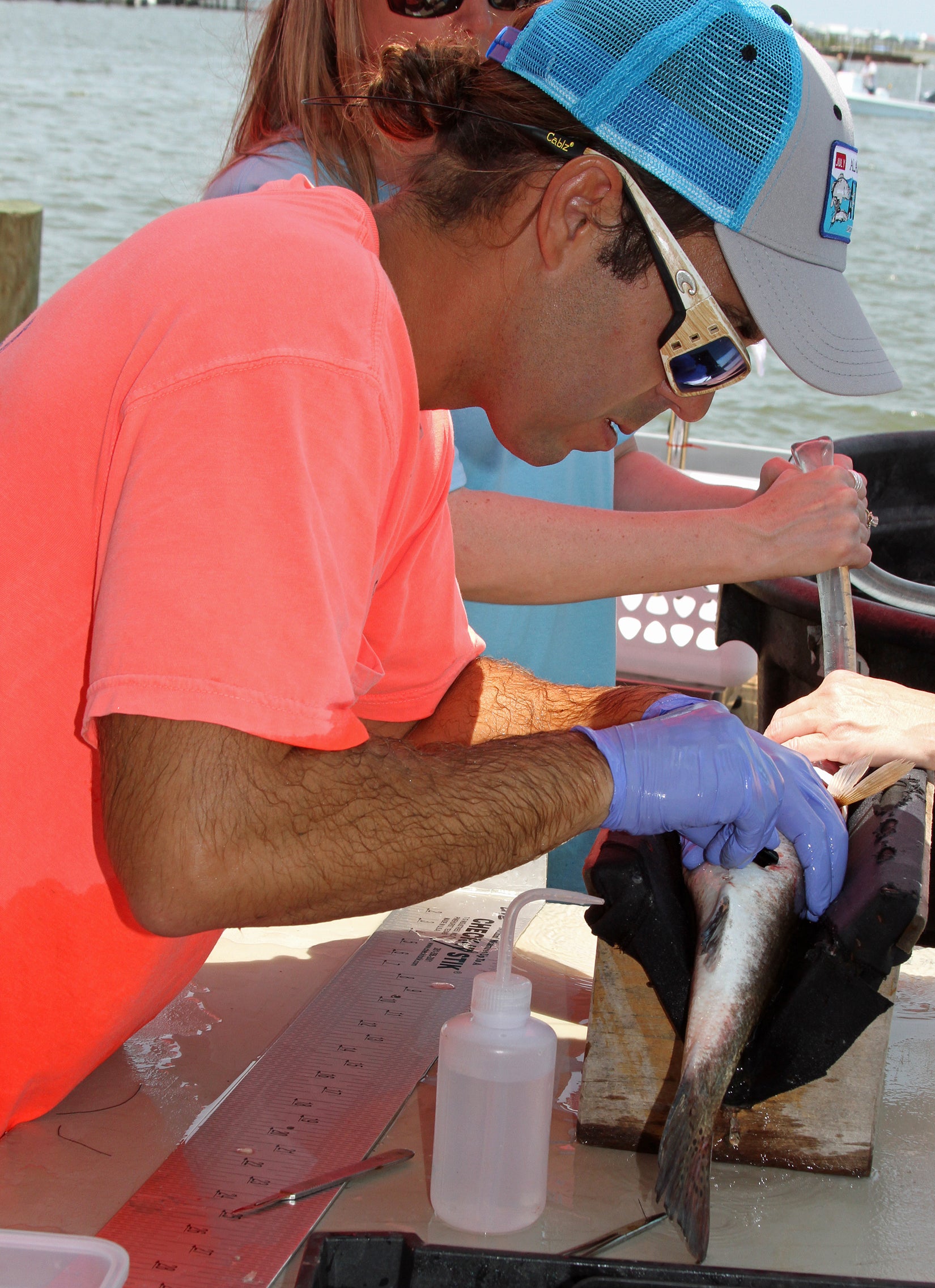By DAVID RAINER, Alabama Department of Conservation and Natural Resources
While the fanfare surrounding the Alabama Deep Sea Fishing Rodeo (ADSFR) proceeded nearby, Reid Nelson deftly made a series of surgeon’s knots to sew up an incision on the belly of a redfish that was a part of the live weigh-in category at the rodeo.
Nelson, a graduate student in the University of South Alabama’s Marine Sciences Department, inserted an acoustic tag in the redfish, red drum if you’re a purist or marine scientist, as part of the Coastal Alabama Acoustic Monitoring Program (CAAMP).
CAAMP monitors 55 receiver stations strategically placed in Alabama coastal waters to catch pings, which happen once a minute during the one-year lifespan of the acoustic tags in the fish.
Nelson said 100 red drum were tagged in 2015. In 2016, another 100 red drum were tagged. Also in 2016, all tagging that didn’t occur at the ADSFR was transferred to Dog River and Fowl River on the western shore of Mobile Bay.
Nelson said the goal of CAAMP is to study fishing mortality, natural mortality and fish movement in response to water temperature and salinity levels.
Last year, the team added speckled trout to the tagging program and will continue to work with trout this year. As expected, redfish is a hardy species that handles catch-and-release very well. Speckled trout are not quite as resilient but still survive well enough to justify the live-release effort.
“With the popularity of the live weigh-in at the rodeo, we looked at it as a nice opportunity to tag live fish from different places,” Nelson said. “You can actually look at how successful live weigh-ins are. What we have seen from fish tagged at the rodeo, about 98 percent of the red drum have lived. About 78 percent of the speckled trout that we tagged at the rodeo have lived.
“Overall, mortality is pretty low, which I think is amazing. Some of the red drum were brought from all over, as far away as Mississippi and Louisiana.”
Nelson said 20 red drum and 15 speckled trout were fitted with the acoustic tags, which cost about $300 each, and released during the 2018 ADSFR. CAAMP is funded through the Alabama Marine Resources Division with a grant from the National Fish and Wildlife Foundation.
“What was really interesting about the rodeo is the map where the fish came from that were released at the rodeo,” he said. “One of the main concerns about a live weigh-in program is the fish won’t leave that area once they are released. Unlike the fish we tagged in the rivers, the fish we tagged at the rodeo leave Dauphin Island pretty readily. We’ve detected those fish as far away as Raft River in the Mobile Delta. We’ve detected them in Fowl River. We’ve detected them off the Gulf State Park Pier. They have even been detected by receiver arrays that other groups have out. It’s really remarkable how quickly and widespread these fish disperse.
“It’s interesting to do science with a part of the tournament. That’s really never been done. Another interesting thing is fishermen have been really good about telling us where they caught the fish. What we have seen is about 25 percent of the fish have gone back to where they were caught. With red drum that were caught in the rivers and brought to the rodeo, about 70 percent of those fish will disperse and end up returning to one of our local rivers. That’s been an amazing aspect of the study. We have no idea how those fish find their way back. It could be olfaction or chemoreceptors. It’s probably a combination of many navigation senses.”
Natural mortality with the red drum tagged in the first year of the study has been surprisingly low, according to Nelson. Out of the 100 fish tagged, only three died of natural causes. Fishing mortality took 10 out of the population in Fowl River from 2016-2017, and nine redfish were lost to fishing mortality in Dog River during the same time span.







